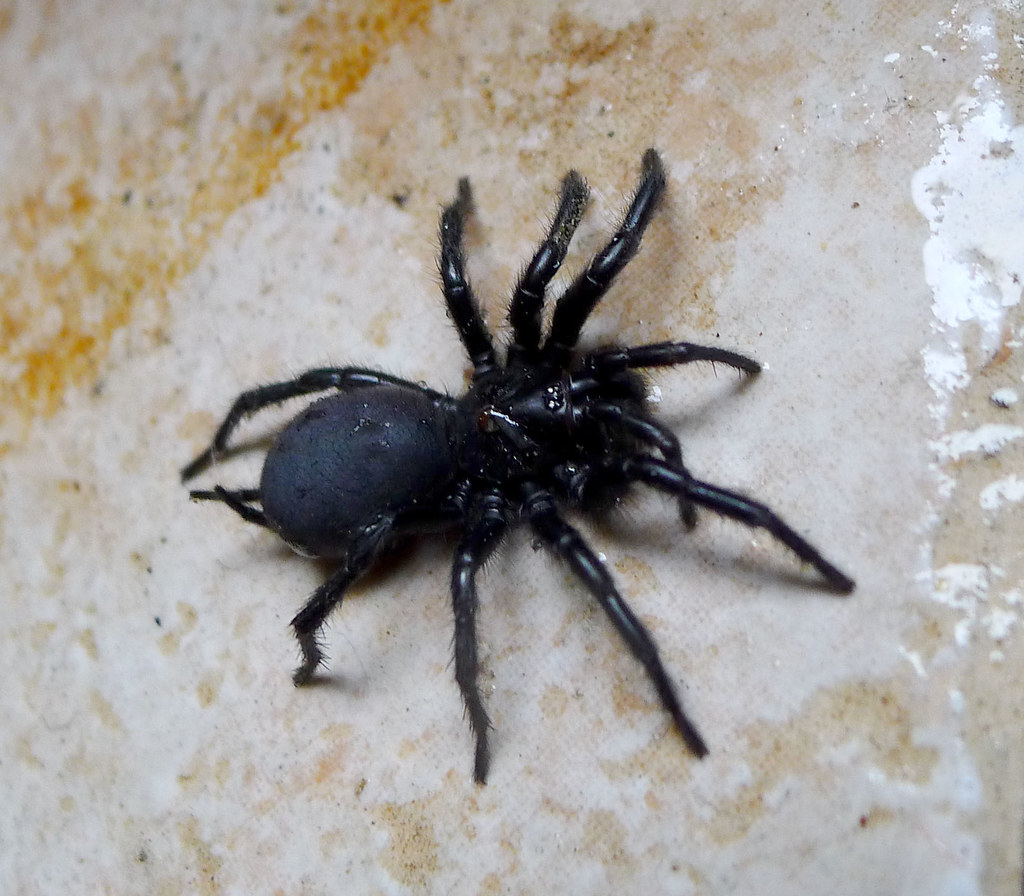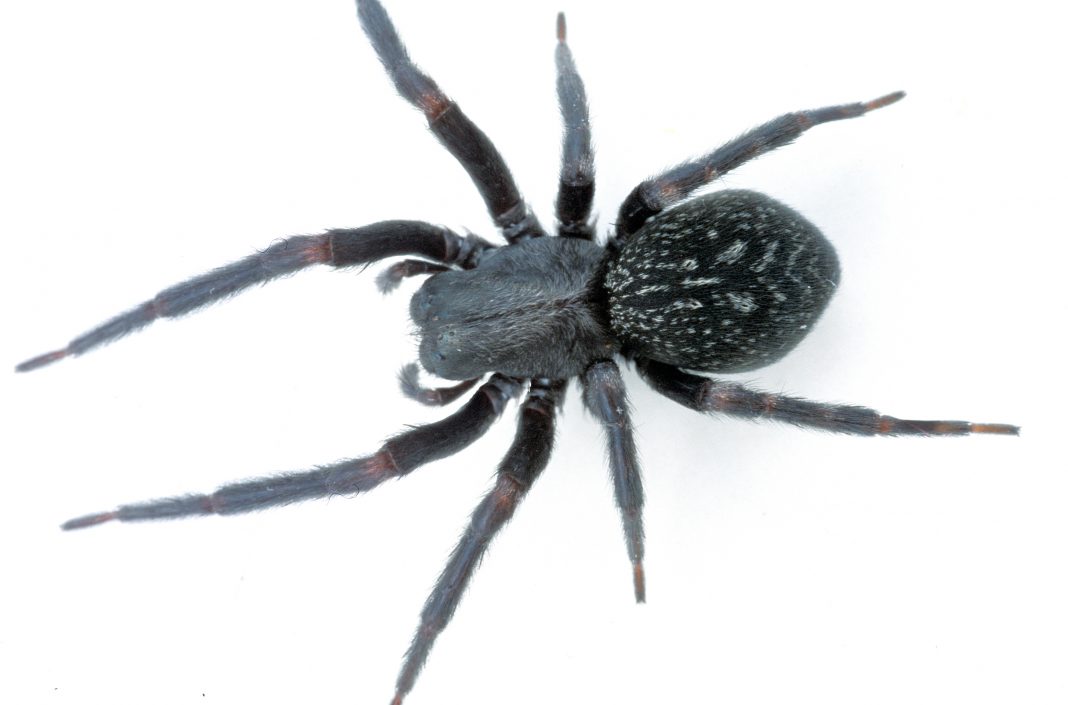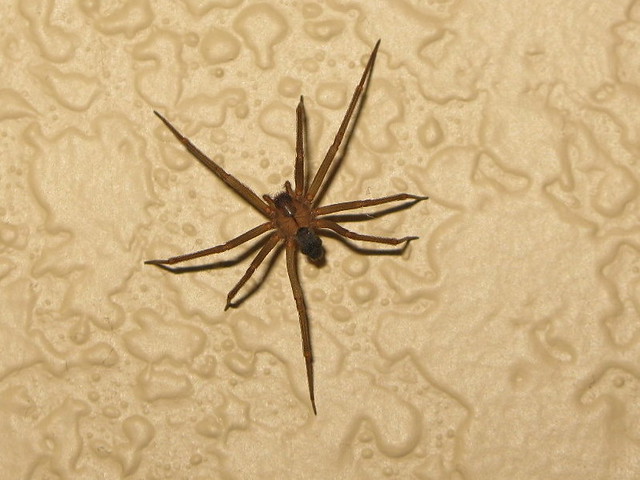Witnessing the myriad wildlife in the Land Down Under is a rare treat; the continent is home to some of the most exotic species in the whole world. While most of these creatures can be admired in different sanctuaries, parks, and zoos, there are some that you need to steer clear of – like Mr. Long Legs. Some spiders in Australia are among the most venomous spiders in the world that can leave you with nasty bites. Here’s a roundup of these scary, eight-legged, creepy-crawlies you should avoid at all costs if you’re in Australia.
Also Read: 10 Most Venomous Snakes In The World
Top 10 Dangerous And Venomous Spiders In Australia
1. Sydney Funnel-Web Spider: One Of Australia’s Most Fearsome Spiders

Considered the world’s most dangerous spider, the Sydney Funnel-Web Spider is a recurring presence in New South Wales, found both in back gardens and bushlands. It’s known for its mighty fangs (that can pierce through fingers and toenails!!) and its foul temper. Funnel-web spider bites are extremely toxic and can cause the human nervous system to shut down, resulting in death in 15 minutes flat.
Luckily, the anti-venom was discovered in 1981 after which fatalities haven’t been recorded. Still, don’t forget to run the other way if you spot one!
Impact on humans:
The venom of funnel-web spiders contains a compound that makes the venom extremely toxic for humans and other primates. It begins with tingling around the mouth, twitching of the tongue, profuse salivating, watery eyes, sweating, and muscle spasms. Hypertension and an elevated heartbeat occur which, when combined with respiratory distress may be very severe and potentially lethal.
Size:
The Sydney funnel-web has a body length ranging from 1 to 5 cm (0.4 to 2 in).
Which specific areas are they found?
This species of venomous mygalomorph spider is native to eastern parts of Australia and is usually found within a 100 km (62 mi) radius of Sydney in New South Wales. But it can also be found in Western Australia.
What does it eat?
The Sydney funnel-web spider’s diet consists mostly of insects, although animals as large as frogs and lizards may also be eaten.
2. Redback Spider: The Australian Black Widow

Redback spiders made headlines in 2016 for killing a young Sydneysider. A Redback spider is highly venomous with a distinctive notable red stripe on its body. It is found throughout Australia (from bushes all the way to urban dwellings) but often makes a home out of sheltered, quiet places like mailboxes or under toilet seats.
There are many reported cases of bites each year but not too many are considered potentially deadly. A small number are treated with anti-venom. Apart from the case in 2016, there has been no reported death because of the arachnid since the anti-venom was made available in 1950.
Impact on humans:
The bite of a Redback Spider (Latrodectus hasselti) is capable of causing death, especially in small children, and any bite should be treated with the utmost caution. A redback spider injects the venom directly into the nerves, resulting in the release and subsequent depletion of neurotransmitters. The symptoms include pain (which can become severe), sweating (always including local sweating at the bite site), muscular weakness, nausea, and vomiting.
Size:
Female Redneck Spiders have a body length of about 1 centimetre (0.39 in), while the males are smaller, being only 3–4 mm (0.12–0.16 in) long.
Which specific areas are they found?
Believed to originate in South Australia or adjacent Western Australian deserts, Redback spiders are now found throughout Australia, Southeast Asia, and New Zealand, with colonies elsewhere outside Australia.
What does it eat?
Insects are the usual prey but they can also capture quite large animals, such as male trapdoor spiders, king crickets, and small lizards if they become entangled in the web.
3. Mouse Spider: With Fangs That Move In And Out Sideways

The mouse spider (missulena) is usually found in bushes, burrows, or slithering its way into suburban backyards. A total of eight species of the mouse spider are spread out across the expanse of the country and are considered one of the most lethal spiders.
They are mostly sedentary and the females enjoy the peace and quiet of their burrows. The male of the species is found wandering around in search of them. Mouse spiders frequently roam around during the daytime in the heat.
Impact on humans:
In most cases, bites by this species cause only minor or moderate effects. Their venom is like that of the funnel-web, but there have been no fatalities linked to their bites. Some mouse spiders have a very toxic venom which is potentially as dangerous as that of the Sydney Funnel-web Spider. However, unlike funnel-web spiders, the mouse spider is believed to use less venom and possibly even “dry bite”.
Size:
Its size varies from 10 mm – 35 mm.
Which specific areas are they found?
Mouse spiders are found over much of mainland Australia, in habitats ranging from open forest to semi-arid shrubland.
What does it eat?
Insects are the main prey of mouse spiders but their diet could possibly include small vertebrates and other spiders.
4. Trap Door Spider: Close Relatives Of Tarantulas

These spiders are named after their clever strategy to trick their prey. They hide at the entrance of their burrows to lure their prey into the false security of their lair. Found throughout the country, the trap door spider has mostly harmless bites with minor symptoms. The males are known to bite more than the females.
Spiders usually live for only a few short years but these spiders can live up to the age of 20.
Impact on humans:
The bite of the Trapdoor Spider is of low risk (non-toxic) to humans. While not very dangerous, local pain and swelling may occur if bitten.
Size:
Their body is 2.5 cm (one inch) or more in length.
Which specific areas are they found?
You can find Trapdoor spiders in Japan, Africa, South America and North America, and many other warm places.
What does it eat?
Common prey of trap door spiders include crickets, moths, beetles, and grasshoppers, but they also eat bigger animals such as birds, bandicoots, centipedes, scorpions, parasitic wasps, and flies.
5. White-Tailed Spider: Vagrant Hunters

White-Tailed spiders are named after the distinctive white stripe on its body. Native to Southern and Eastern Australia, it is found both in natural and urban landscapes. These nomadic critters wander by night in search of food which is, in fact, other lesser powerful and dangerous spiders.
They are not known to bite humans that frequently, but bites by two specific species of the white-tailed spider – Lampona cylindrata and Lampona murina – have led to mild symptoms such as localised pain. There has not been any other recorded health risk.
Impact on humans:
The venom from the white-tailed spider is listed as non-lethal. In most cases, being bitten by a white-tailed spider cause a mild reaction, including itching and skin discolouration, which usually resolves after a few weeks.
Size:
The body size is up to 18 mm, with legs spanning of 28 mm.
Which specific areas are these spiders found?
White-tailed spiders are native to southern and eastern Australia.
What does it eat?
The white-tailed spider’s main prey is other spiders. It is an active hunter and prefers to stalk the spiders while they are in their own webs. The black house spider, in particular, is a favourite food item.
6. Black House Spider: Also Referred To As Window Spiders

As its name suggests, the Black House Spider is found to live mostly indoors. They are common throughout Australia and have a maximum leg span of around 30 mm. They build tangled webs (that can often become quite messy and extensive) with a funnel-like retreat and wait for their prey to arrive.
Though not too dangerous, the bite of this spider has been described as excruciatingly painful with local swelling. Other symptoms that accompany the bite are nausea, sweating, vomiting, etc. Sometimes mild necrosis has caused skin lesions, though this happens only after several bites.
Impact on humans:
Blackhouse spiders are venomous but are not considered dangerous. Death from the venom of blackhouse spiders is extremely rare. They are timid and bites from them are infrequent. The bite may be excruciatingly painful and can cause local swelling. Symptoms such as nausea, vomiting, sweating, and giddiness are occasionally recorded.
Size:
Females grow up to 18mm, with a 30mm leg length, while the males are smaller (10mm).
Which specific areas are these spiders found?
Black house spiders are widely distributed throughout Australia and New Zealand. In their natural habitat, they are usually found on rough-barked trees, whereas inside buildings they are often found in corners, around windows and doorways, or other light sources that may attract prey.
What does it eat?
Their diet includes invertebrates such as flies, beetles, butterflies, bees, and ants.
7. Australian Tarantulas: Often Known As Whistling Or Barking Spiders

These tarantulas are the largest spiders on the Australian continent. The length of their leg is a whopping 22 cm with fangs of up to 1 cm. They are also the longest-living of the Australian spiders; some females reach the age of 30 (the males, however, last only 8 years).
Their fangs are big but the bites aren’t venomous. It will leave you in pain and could cause nausea and vomiting. These spiders are more fatal to pets than to humans. Tarantula bites on dogs and cats have been found to be fatal in certain instances.
Impact on humans:
Their bites aren’t fatal to humans however dogs have been reported to be especially sensitive to tarantula envenomation and death is reported to occur in 30–120 min for most dogs. Despite being non-fatal, their bites rarely can cause vomiting and fever.
Size:
They are 6 cm in length and have up legs that measure up to 16 cm.
Which specific areas are these spiders found?
Tarantulas are widely distributed throughout the Australian continent and North Queensland
What does it eat?
The tarantula is a carnivore and eats large insects, small reptiles, frogs, and occasionally small birds.
8. Fiddleback /Recluse Spider: Had Six Eyes Instead Of Usual Eight

The recluse spider is infamous for the flesh-eating properties of its venom which has gained widespread attention. Their bites can leave large areas of skin and flesh destroyed and the injuries are slow to heal. Sometimes the healing process might even require the aid of skin grafts. In some of the worst cases, limbs have had to be amputated. The recluse spider has been the cause of many deaths around the world.
Thankfully, the recluse spider is not known to be aggressive and bites rarely. Their small fangs limit their ability to give out venom. Most bites usually leave mild symptoms. The range of the spider comes as another relief, they usually stay limited to small pockets and there hasn’t been a recorded case of this spider biting someone in about 20 years. Nonetheless, be wary!
Impact on humans:
A brown recluse spider’s bites are often not felt when it happens. The complex venom causes injury and death (necrosis) of the surrounding tissues. In severe cases, the venom can damage deeper tissues. Serious illness and death are rare. There is no antidote; treatment includes treating the wound and preventing infection. The pain may be described as dull and numbing. Within 1 hour after envenomation, there may be progression to persistent local pain, diaphoresis, erythema, and piloerection at the bite site.
Size:
The recluse spiders are nearly 1/4 (dime) to 1/2 inch (quarter) in body size.
Which specific areas are these spiders found?
Other than Australia, Brown recluse spiders live in a region comprising Kansas, Oklahoma, Texas, Louisiana, Arkansas, Missouri, Mississippi, Alabama, and parts of Georgia, Tennessee, Kentucky, Ohio, Indiana, Illinois, Iowa, and Nebraska.
What does it eat?
A carnivore, recluse spiders eat soft-bodied insects such as crickets, cockroaches, moths, and flies.
9. Common Garden Orb Weaver Spider: From The Third Largest Family Of Spiders

As the name suggests, common garden orb weave spiders are a very common species of spider with many variants in size, shape, and colour. They have very large abdomens when well-fed and exhibit a tremendous colour-range from off-white through tan, brown to almost black. These are the most common spider species to bite and are quite aggressive, hence classified amongst dangerous spiders. They live in the gardens and generally weave webs between trees, on hedges, or washing lines at night. These spiders hide during the day and rest with their legs withdrawn under the body, hanging off a thread under a leaf, or in the clothes hanging from the line.
Impact on humans:
The venom of Orb-Weaving Spiders is of low risk (not toxic) to humans. The venom usually causes negligible or mild local pain, numbness, and swelling. Occasionally nausea and dizziness can occur after being bitten.
Size:
The common Garden orb weaver spider is about 20 mm to 30 mm in size.
Which specific areas are these spiders found?
Common Garden orb weaver spider is found in eastern and southern coastal areas of Australia.
What does it eat?
Orb Weaver spiders mainly each insect as their main diet.
10. Huntsman Spiders: Giant Crab Spiders

Named so because of their speed and mode of hunting, the Huntsman spiders are widespread in the country. They belong to the family Sparassidae and are famed as being the hairy so-called ‘tarantulas’ on house walls. These large, long-legged spiders are mostly grey to brown, sometimes with banded legs. While they may look scary, in reality, they are reluctant to bite and are more likely to run away when approached. Despite their intimidating size, huntsman spiders can be an ally in the house; many Australians will relocate Huntsmen to the garden rather than kill them.
Impact on humans:
Their venom isn’t considered dangerous for humans. The venom of Huntsman spiders can cause prolonged pain, inflammation, headache, vomiting, and irregular pulse rate.
Size:
The huntsman spider typically has a 1-inch body and a leg span of up to 5 inches, though larger ones can have legs going up to 12 inches long.
Which specific areas are these spiders found?
These spiders are generally widely distributed across Australia, although Brown Huntsman species is absent from most of Southeastern Australia and Tasmania has only a few Huntsman species.
What does it eat?
Its diet consists of insects and other invertebrates.
What Will You Do If You Encounter One Of These Australian Spiders?
So here are some of the top venomous eight-legged critters from the Land Down Under. These dangerous Australian spiders are really something. They usually live in sheltered places or garden sheds but that doesn’t mean they can’t sneak up on you. Now that you know some of the common spiders found here, keep far away from these spider species (or call pest control)!
Also Read: 10 unique wildlife experiences to try in Australia
Funnel Web Spiders are the deadliest Spiders.
No fatalities have been recorded in the country from a confirmed spider bite since 1979.
Sydney Funnel Web Spider is the most venomous spider in the country.
Selenocosmia crassipes Tarantula is the largest spider.


